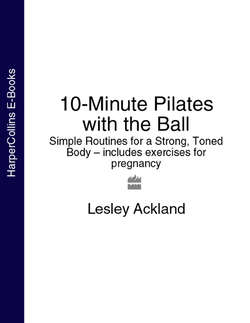Читать книгу 10-Minute Pilates with the Ball: Simple Routines for a Strong, Toned Body – includes exercises for pregnancy - Lesley Ackland - Страница 7
ОглавлениеEssentials
Because Body Maintenance is a very precise system of exercise, it is important that you first become acquainted with the basic principles. This groundwork will help you fully understand what you are doing. There are six essential guidelines to follow.
1 BREATHING
It is important to be aware of the relationship between breath and movement. Emphasized in dance but rarely addressed at the gym, breathing correctly is fundamental to Pilates. For most exercises in this book, you should breathe out at the point of effort.
As oxygen nourishes the brain and the body, it is crucial to breathe deeply, right down into the lower lobes of your lungs, not just using the upper chest. Most people are stronger on one side of their body than on the other, looser on one side and tighter on the other. Pilates uses breathing and exercise to create balance in the body.
Breathing deeply, you’re working from the inside out, energizing and replenishing large areas of your body. It is as spiritual as it is physical. Breathing into a tight area that is being stretched after a long time is rejuvenating. Think of breathing as a form of liberation.
2 CONTROL
‘Control’ in this instance means that the correct part of the body is used in each exercise. By focusing on a particular muscle group, you are able to minimize the stress and involvement of other parts of the body. Doing an abdominal curl without this kind of focus and attention, for example, often leads to straining of the neck, shoulders and hip flexors, instead of working the abdominal muscles.
All exercises must be done slowly and in a meditative fashion. Control and precision are key. Your mind must concentrate on what you’re doing. It is preferable to do 10 repetitions in a thoughtful and regulated way than to do a 100 mechanically, using only momentum. When working with free weights, for example, you should be able to use internal resistance rather than using your shoulders or snapping your elbows. Similarly, in the pelvic tilts you should be able to feel one vertebra at a time. Pilates is about being sensitive to your body.
People often make what is a simple exercise into something that is torturous, thus creating distortion and tension. Proper control makes each exercise efficient by concentrating on each muscle group, while keeping the rest of the body relaxed and aligned.
3 CENTRING
Pilates encourages the development of one strong, core area that controls the rest of the body and supplies it with energy. This core is the centre of your body: the continuous band between the bottom of your ribcage and across the line of your hipbones. The area’s stomach and back muscles support your spine and internal organs, and keep you upright.
This central stability supports its various extensions – the arms, legs and head. Having a strong core means you can walk and run without discomfort or pain. Similarly, a strong centre results in a strong back, and backache can be alleviated by strengthening the core muscles.
Human beings were not originally designed to stand up straight. As gravity is constantly pulling us forward, it explains why so many people have problems associated with the neck and shoulders. We are basically defying nature, gravity and our initial body type by walking and standing upright.
4 FLOW
If any action feels quick, jerky or sharp, you can be sure that you are performing the exercise incorrectly. Every movement in Pilates originates from a strong centre and flows out in a slow, gentle, controlled manner. This warms the muscles, causing them to lengthen and open up the spaces between each vertebra in the spine, extending the body. The result is a longer, leaner look.
5 PRECISION
Performing Pilates with precision ensures that each movement is working the body in the correct manner. It is therefore important to read the instructions carefully before starting an exercise sequence. Make sure you are properly aligned, and pay attention to the ‘Watchpoint’ notes. This will ensure that you do not expend excess energy doing an exercise incorrectly.
6 CO-ORDINATION
Children run and bend naturally, but for most adults basic co-ordination is a major problem. When starting Body Maintenance, I have heard people say, ‘I can’t co-ordinate my breath with the movement. It’s too much. I’ve got to concentrate too hard. I can’t do it.’ Many people have lost the ability to co-ordinate their bodies and minds as parts of the same working machine. The aim of Pilates is to retrain the neuromuscular connection between the brain and the body.
We all have the capability to be in touch with every part of our body, but we often don’t use it. Those who have lost the use of their hands, for instance, have been known to train their feet to carry out many of the same functions. Yet for most of us, employing our feet in this way would seem impossible. If you don’t utilize a part of your body, it atrophies. You have to think of co-ordination in much the same way.
By co-ordinating your breath and using a strong centre, getting your right arm and opposite (left) leg to work together without any difficulty is possible. The ability to react spontaneously is a result of the neuromuscular connection between brain and body. This is where the proprioceptive concept – the linking of mind and body – comes into play. Pilates enhances this sense of co-ordination in every exercise sequence through breath and precision.
